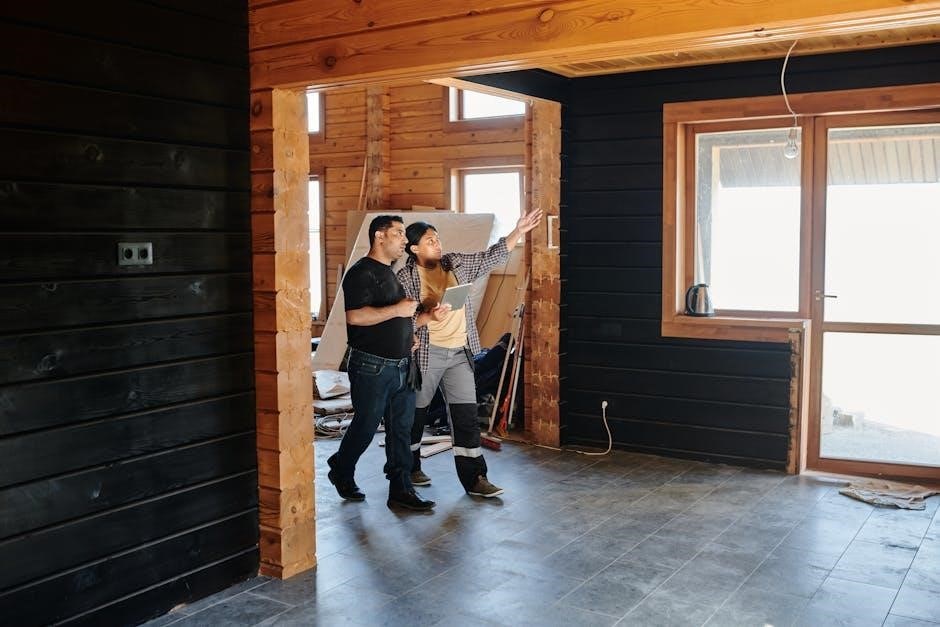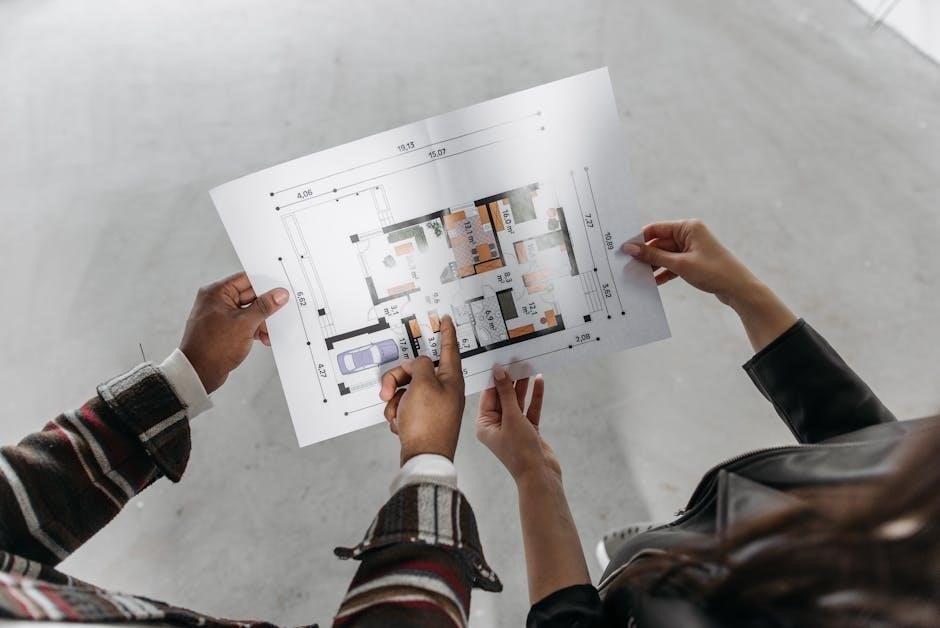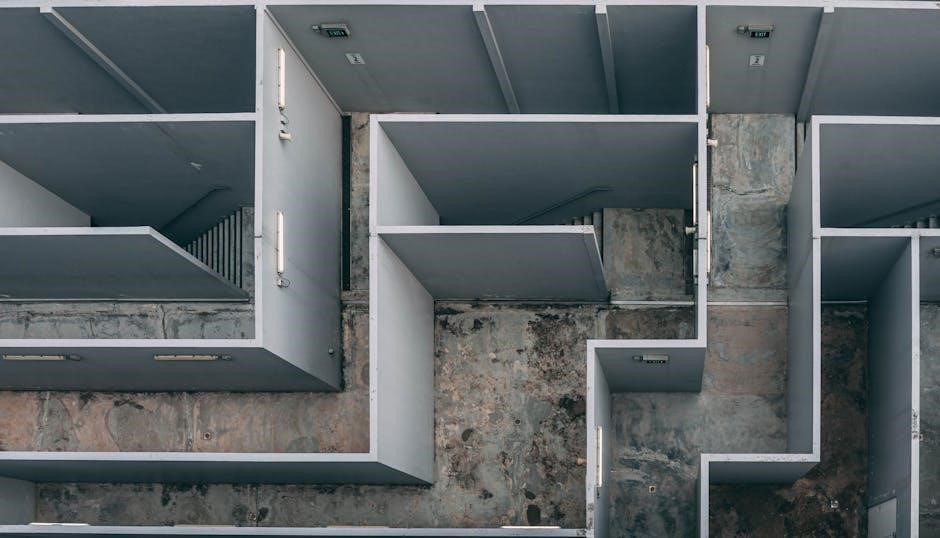A PDF floor plan is a digital representation of a building’s layout‚ offering scalability‚ portability‚ and consistent viewing across devices. It is widely used in architecture‚ real estate‚ and interior design for clear communication and precise measurements.
1.1 What is a PDF Floor Plan?
A PDF floor plan is a digital‚ portable document format file that visually represents the layout of a building’s floors. It typically includes walls‚ doors‚ windows‚ rooms‚ and measurements‚ providing a clear‚ scalable‚ and printable overview of a space. PDF floor plans are widely used in architecture‚ real estate‚ and interior design for their precision and compatibility across devices. They often serve as blueprints for construction‚ remodeling‚ or furniture arrangement. The format allows for layers‚ annotations‚ and high-quality images‚ making it ideal for professional and DIY projects. PDF floor plans can also be easily shared and edited using specialized software‚ ensuring consistency and accuracy in design and planning processes.
1.2 Importance of PDF Floor Plans in Architecture and Design
PDF floor plans are essential in architecture and design due to their universal compatibility‚ scalability‚ and security. They maintain consistent formatting across devices‚ ensuring that intricate details remain intact. Architects and designers rely on PDFs for sharing precise blueprints‚ as they are easily accessible and printable. The format supports layers‚ annotations‚ and high-resolution images‚ making it ideal for collaborative projects. PDF floor plans also enhance security‚ as they can be password-protected to safeguard sensitive designs. Their portability and professional presentation make them a standard in the industry‚ facilitating clear communication between stakeholders. This versatility streamlines workflows‚ from conceptualization to execution‚ making PDF floor plans indispensable in modern architectural and design practices.

Benefits of Using PDF Floor Plans
PDF floor plans offer scalability‚ portability‚ and universal compatibility across devices. They ensure secure sharing‚ maintain design integrity‚ and provide a professional format for collaboration and presentation.
2.1 Scalability and Portability of PDF Floor Plans
PDF floor plans are highly scalable‚ allowing users to zoom in and out without losing quality‚ making them ideal for detailed reviews or presentations. Their portability ensures seamless sharing across devices and platforms‚ maintaining consistent formatting regardless of the viewer. This adaptability is crucial for architects‚ designers‚ and clients collaborating on projects. PDFs can be easily emailed‚ uploaded‚ or stored‚ facilitating efficient communication. The ability to scale and maintain clarity enhances usability in various settings‚ from small screens to large prints‚ ensuring that floor plans remain accessible and professional in every context.
2.2 Security and Compatibility Across Devices
PDF floor plans offer robust security features‚ such as encryption and password protection‚ ensuring that sensitive architectural data remains confidential. Their compatibility across devices is unparalleled‚ as PDFs can be viewed on any operating system‚ smartphone‚ or tablet without requiring specialized software. This universal accessibility makes PDFs ideal for sharing floor plans among architects‚ contractors‚ and clients. Additionally‚ PDFs maintain consistent formatting‚ ensuring that the layout and design remain intact regardless of the device used. This reliability is crucial for professional presentations and collaborations‚ where accurate and secure representation of floor plans is essential. The combination of security and cross-device compatibility makes PDF floor plans a reliable choice for modern architectural workflows.

How to Create a PDF Floor Plan
Import your floor plan as a PDF or image‚ align the drawing scale‚ use layers for customization‚ and export the finalized plan for sharing and collaboration.
3.1 Step-by-Step Guide to Designing a Floor Plan
Designing a floor plan involves several key steps to ensure accuracy and clarity. Start by launching your chosen design software and selecting the floor plan template. Import your PDF or image as a background layer‚ adjusting opacity for traceability. Next‚ align the drawing scale to match the plan’s measurements for precision. Begin by drawing walls‚ doors‚ and windows‚ using tools to snap to grids or existing elements. Add furniture and fixtures‚ ensuring proper spacing and layout. Use layers to organize elements like walls‚ furniture‚ and annotations. Finally‚ review the plan for accuracy and export it as a PDF for sharing or further editing. This structured approach ensures a professional and functional floor plan design.
3.2 Converting CAD Drawings or Images to PDF Format
Converting CAD drawings or images to PDF format is a straightforward process that ensures compatibility and professional presentation. Open your CAD software and load the drawing. Use the built-in export or print function‚ selecting PDF as the output format. Adjust settings like resolution and scaling to maintain clarity. For images‚ use graphic design tools like Adobe Illustrator or online converters to transform JPEGs or PNGs into PDFs. This method preserves the visual integrity of the floor plan while enabling easy sharing and viewing across devices. Ensure the PDF is high-resolution to retain intricate details‚ making it suitable for both digital and printed formats. This conversion is essential for maintaining consistency and professionalism in architectural and design projects;

Tools for Creating and Editing PDF Floor Plans
Popular tools like Adobe Acrobat‚ AutoCAD‚ and Canva enable precise creation and editing of PDF floor plans‚ offering features like scaling‚ layer management‚ and furniture placement for detailed designs.
4.1 Popular Software for Floor Plan Design
Popular software for creating PDF floor plans includes AutoCAD‚ Revit‚ and SketchUp‚ offering advanced tools for precise designs. Adobe Acrobat and Illustrator enable editing and enhancement of PDFs‚ while Canva provides user-friendly templates. EdrawMax and Microsoft Visio are also widely used for detailed layouts and scalability. These tools support layers‚ 3D views‚ and furniture placement‚ ensuring high accuracy and customization. Whether for architectural projects or interior design‚ these applications streamline the process of creating and refining floor plans for professional and personal use. Their versatility and features make them indispensable in various industries‚ from real estate to event planning.
4.2 Using Online Floor Plan Creators
Online floor plan creators like Canva‚ HomeStyler‚ and EdrawMax offer intuitive tools for designing PDF floor plans without downloading software. These platforms provide templates‚ drag-and-drop symbols‚ and real-time collaboration features. Users can import images or PDFs‚ align scales‚ and customize layouts. Many online tools support 3D visualization‚ allowing users to explore spaces virtually. They are ideal for DIY projects‚ small businesses‚ and professionals seeking quick‚ cost-effective solutions. With cloud-based access‚ designs can be shared and edited effortlessly‚ making online floor plan creators a versatile choice for various applications‚ from home renovations to commercial layouts.

Importing and Working with PDF Floor Plans
PDF floor plans can be imported into software like Illustrator or CAD for editing. Align scales‚ use layers for customization‚ and export plans for precise measurements and collaboration.
5.1 How to Import PDF Floor Plans into Illustrator
To import a PDF floor plan into Adobe Illustrator‚ open the program and select File > Place. Choose your PDF file and select “OK.” The PDF will be placed as a vector object‚ allowing you to edit and manipulate elements like walls‚ doors‚ and windows. Adjust the scale and alignment to ensure accuracy. Use the Pen or Shape tools to trace over the PDF layout‚ creating editable layers. Lock the PDF layer to avoid accidental modifications. This method enables precise vectorization of your floor plan for further customization‚ such as adding furniture or annotations. The imported PDF serves as a reliable base for creating detailed‚ scalable designs suitable for architecture‚ interior design‚ and real estate applications.
5.2 Using PDF Floor Plans in CAD Software
Importing a PDF floor plan into CAD software allows architects and designers to leverage precise vector data for further modifications. Open your CAD program‚ such as AutoCAD or BricsCAD‚ and use the PDF Import or Underlay tools to load the file. Once imported‚ the PDF serves as a reference layer‚ enabling you to trace walls‚ doors‚ and other structural elements with CAD tools. Adjust the scale and alignment to match your project requirements. Use layers to organize elements like furniture or annotations. This integration enhances collaboration and ensures accuracy. Many CAD programs support PDF underlays‚ making it easy to work with existing floor plans while maintaining scalability and precision.

Customization and Design Elements
PDF floor plans allow users to add furniture‚ fixtures‚ and customize layouts for precise design. Scaling and aligning ensure accuracy‚ while layers help organize elements for clarity.
6.1 Adding Furniture and Fixtures to PDF Floor Plans
Enhance your PDF floor plans by adding furniture and fixtures to create realistic and functional layouts. Use design software to drag-and-drop symbols from built-in libraries or import custom elements. This feature is particularly useful for interior designers and homeowners to visualize room arrangements and spatial relationships. Many tools allow users to adjust sizes‚ rotate objects‚ and align items precisely. For example‚ placing sofas‚ tables‚ and appliances helps in understanding how spaces will be utilized. This step is essential for interior design projects‚ as it transforms a basic floor plan into a detailed‚ actionable blueprint. Layers can also be used to organize furniture and fixtures‚ making it easier to toggle between different design options.
By incorporating furniture and fixtures‚ users can better communicate their vision to clients or stakeholders. This level of customization ensures that the final design meets both aesthetic and functional requirements‚ making PDF floor plans indispensable for precise interior planning and collaboration.

6.2 Scaling and Aligning PDF Floor Plans for Accuracy
Scaling and aligning PDF floor plans ensure precision and accuracy‚ making them essential for professional use. Proper scaling guarantees that measurements are consistent‚ while alignment ensures elements are positioned correctly. Use grids or snap-to-grid features in design software to maintain symmetry and order. Layers can help organize different aspects of the plan‚ such as walls‚ doors‚ and furniture‚ allowing users to adjust and align elements independently. Accurate scaling is crucial for printing or sharing plans‚ as it ensures that the layout appears correctly on all devices. By carefully scaling and aligning‚ users can create visually appealing and functional floor plans that meet architectural and design standards. This attention to detail is vital for effective communication and successful project execution.
Exporting and Sharing PDF Floor Plans
Exporting PDF floor plans from design software ensures scalability and clarity. Sharing options allow collaboration‚ enabling stakeholders to review and provide feedback efficiently‚ enhancing project coordination and execution.
7.1 Exporting Floor Plans from Design Software
Exporting floor plans from design software is a straightforward process that ensures high-quality output. Tools like Adobe Illustrator‚ Microsoft Visio‚ and specialized floor plan software allow users to export their designs as PDFs‚ maintaining scalability and vector graphics quality. This feature is particularly useful for preserving intricate details and ensuring that the floor plan remains clear and legible at any scale. Many software options also support layer management‚ enabling users to toggle specific elements before exporting. Additionally‚ exporting as PDF ensures compatibility across devices and platforms‚ making it easy to share and collaborate with stakeholders. The process typically involves selecting the export option‚ choosing the PDF format‚ and adjusting settings for resolution and compression to optimize the file size while maintaining precision and clarity;
7.2 Sharing and Collaborating on PDF Floor Plans
Sharing and collaborating on PDF floor plans is seamless due to their universal compatibility. Designers and stakeholders can easily distribute the files via email or cloud storage platforms like Google Drive or Dropbox. The PDF format ensures that the layout and details remain consistent across different devices and software‚ reducing miscommunication. Security features such as password protection and watermarks can be added to safeguard sensitive information. Additionally‚ many PDF editors and collaboration tools allow real-time annotations and comments‚ enabling teams to provide feedback efficiently. This functionality is particularly valuable in architecture and real estate‚ where multiple parties often need to review and approve plans. Cloud-based solutions further enhance collaboration by granting access to the latest versions‚ ensuring everyone is on the same page. This streamlined process promotes productivity and ensures accurate execution of designs.

Real-World Applications of PDF Floor Plans
PDF floor plans are essential in real estate for property listings‚ virtual tours‚ and space planning. They aid event organizers in visualizing venue layouts and seating arrangements. Architects and designers use them for presenting projects‚ while facility managers rely on them for space optimization. Additionally‚ PDF floor plans are invaluable during furniture arrangement and relocation planning‚ ensuring efficient use of space.
8.1 PDF Floor Plans in Real Estate and Property Management
PDF floor plans play a crucial role in real estate and property management by providing clear‚ scalable‚ and shareable layouts of properties. Agents and property managers use them to showcase listings‚ enabling potential buyers or renters to visualize spaces easily. These plans highlight room dimensions‚ layouts‚ and key features‚ making it easier to communicate property details remotely. In property management‚ PDF floor plans aid in optimizing space‚ planning renovations‚ and managing tenant layouts. They also serve as a reference for furniture arrangement and facility maintenance. The ability to share and annotate PDFs fosters collaboration among stakeholders‚ ensuring alignment on design and functional aspects of properties.
8.2 Using PDF Floor Plans for Event Planning and Layout Design
PDF floor plans are invaluable in event planning‚ enabling organizers to visualize and design layouts efficiently. They allow precise scaling and alignment of event spaces‚ ensuring accurate measurements for furniture‚ stages‚ and equipment placement. By importing PDF floor plans into design software‚ planners can experiment with different configurations and share detailed layouts with vendors and stakeholders. This fosters collaboration and ensures everyone is aligned on the event setup. Additionally‚ PDFs can be annotated to mark key areas like entrances‚ exits‚ and service points. This tool is particularly useful for weddings‚ conferences‚ and exhibitions‚ where spatial organization is critical. The ability to print to scale or view in 3D further enhances the planning process‚ making PDF floor plans an essential asset for creating functional and visually appealing event spaces.

Advanced Features of PDF Floor Plans
PDF floor plans offer advanced features like layers‚ 3D views‚ and precise scaling‚ enhancing functionality and customization for detailed design and visualization.
9.1 Adding Layers to PDF Floor Plans
Adding layers to PDF floor plans enhances organization and flexibility; Layers allow users to toggle between different design elements like walls‚ furniture‚ and electrical systems. This feature is particularly useful for architects and designers who need to present multiple scenarios or phases of a project. By separating elements into distinct layers‚ modifications can be made without affecting the entire plan. Additionally‚ layers enable easier collaboration‚ as stakeholders can focus on specific aspects of the design. Tools like Adobe Illustrator and specialized CAD software support layer functionality‚ making it a powerful feature for creating detailed and interactive PDF floor plans.
9.2 Creating 3D Views from PDF Floor Plans
Creating 3D views from PDF floor plans allows for immersive visualization of spaces. This process involves importing the PDF into software like AutoCAD or Revit‚ where vector data can be converted into 3D models. Tools like SketchUp or specialized plugins can also transform 2D floor plans into 3D representations. This feature is invaluable for architects‚ designers‚ and clients to better understand spatial relationships and aesthetics. Online platforms and apps further simplify this process‚ enabling users to upload PDFs and generate 3D views instantly. The ability to explore designs in 3D enhances collaboration and decision-making‚ making it a powerful tool in modern design workflows.

Best Practices for Creating Effective PDF Floor Plans
Use clear templates‚ precise measurements‚ and intuitive tools to ensure accuracy. Incorporate layers for customization and maintain scale consistency for professional and functional designs.
10.1 Tips for Clear and Precise Floor Plan Design
Start with a clear template and use built-in symbols for consistency. Ensure accurate measurements by aligning the drawing scale with your plan. Utilize layers to organize elements like walls‚ furniture‚ and annotations. Add furniture and fixtures to visualize spaces better. Use grid snapping for precise alignments and avoid clutter by labeling rooms and dimensions clearly. Test layouts in 3D to verify functionality. Export plans in high resolution for professional sharing. These practices ensure designs are both functional and visually appealing‚ making collaboration and execution seamless.
10.2 Ensuring Accuracy and Scale in PDF Floor Plans
Accuracy and scale are critical in PDF floor plans for precise measurements and professional presentation. Begin by setting the correct DPI and units during creation. Use measurement tools in design software to verify distances and angles. Lock layers containing reference images or backgrounds to prevent accidental edits. Ensure consistent scaling across the entire document by aligning all elements to a unified grid. Regularly review and update the plan to reflect any changes. Consider exporting a test version to verify scaling and proportions before finalizing. These steps ensure your PDF floor plans are reliable‚ professional‚ and ready for sharing or printing.



